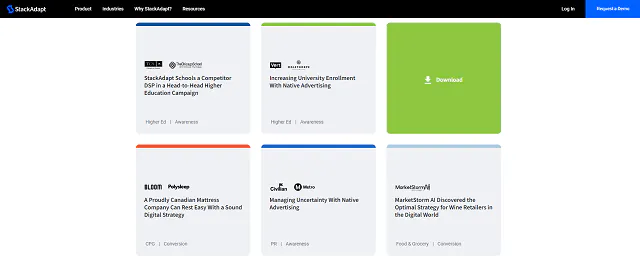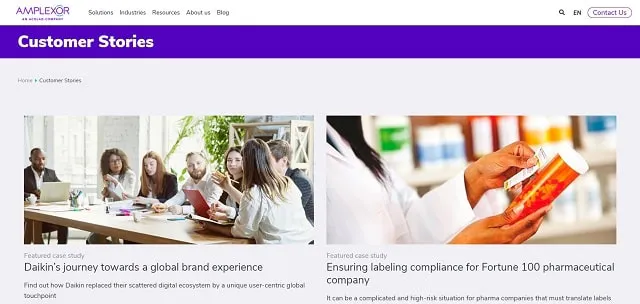When you want a new way to position your company as the solution your customers need, a case study might be the answer. Case studies present information in a straightforward manner. They can also be valuable in offering social proof to people who might still be deciding whether your business is their best option, like an in-depth customer testimonial. There are many ways to make case studies, though, so choosing the best case study format should be your first step.
What’s the Best Case Study Format?
Screenshot via StackAdapt
A written case study is the most common form used today. Whether that case study is written on a website, as a downloadable PDF, or published in a journal, the written form allows readers to scan and digest the information at their own pace. Readers can also refer back to the case study as needed to remember key points.
Many case studies for businesses are in an interview format, with one person being interviewed about their experience with a product, service, or event. That interview then gets turned into a written case study using quotes from the discussion and data provided by the interview subject to prove the benefits of the product, service, or event. These types of case studies are usually effective because they contain information straight from the source.
Common Types of Case Studies
Case studies can take on several forms, depending on how the case study creator wants to use sources and convey the information. Before we get into other case study formats, which are the way information is presented to an audience, let’s look at a few common types of case studies.
Explanatory Case Study
Explanatory case studies are very distinct in that they present data and information to explain results. These case studies are best for delivering data that is very cut-and-dry and not open to interpretation. For example, if your business has clear proof that it’s generated at least 50% sales growth for another company, you can use an explanatory case study to document that data.
Exploratory Case Study
Unlike explanatory case studies, exploratory case studies offer information that could potentially be tested and refuted. These case studies can be good to use if you have some positive preliminary data that you plan to study more in the future. However, it’s important to note that your preliminary data may not present enough solid evidence for those you’re trying to impress, so it’s essential to weigh the potential risks before creating this type of case study.
Collective Case Studies
Collective case studies examine data from multiple people or groups. You might use this case study when you have data from several of your clients that indicate the benefits your product or service provided them. Typically, a collective case study looks at the same data points for each person or group involved to better compare data and results.
Case Study Format Options
Screenshot via Amplexor
Although case studies can take on several forms, the following are some of the most common and popular ways to present them aside.
Web Page Case Study
As we said, written case studies tend to be the most common and recognized in the business world. Sometimes, case studies get published in journals or magazines. But, with more than 59% of the global population using the internet, you might miss a golden opportunity if you don’t put your case study on the web. Head to the news or media section of company websites, and you’ll probably see case studies published as blog posts or web pages. A perk to consider: Website case studies are much more shareable than printed versions. Plus, case studies make excellent ideas for blog posts when you’re short on newsworthy or informative topics to cover in your blog.
Downloadable Case Study
Downloadable case studies can be downloaded as PDFs, printed, and handed out to people at events or meetings. These written case studies usually have a good mix of text and visuals, like graphs, tables, or infographics, to help break up the text. They also are usually in a newsletter format with headings, subheadings, and some white space for visual appeal.
Presentation Case Study
Best for meetings and events where you’ll be speaking about your company, a presentation case study uses slides to offer information. The slides generally have some text, but are mostly visual, allowing you to display data and information while you explain it more in detail as you speak.
Video Case Study
A video case study format is newer to the scene, but it’s becoming a popular way to present information about a company. You can include testimonials and data from real customers, display graphs and other visuals, and use a mix of audio and imagery to boost interest. Video case studies are a valuable form of video marketing and are perfect for businesses seeking to expand their marketing with a YouTube channel.
A case study is a marketing asset that could help your business continue to grow and take on new customers or clients. Nailing the right format is important, but your case study content is ultimately what’s going to drive new sales. Focus on incorporating the most crucial data and presenting it in a way that’s easy to digest for your specific audience, whether that’s through a downloadable PDF, a video, or a quick blog post.
Whatever format you decide on for your case studies, you want them to get as much exposure as possible. Make it easy for your website visitors to share your case studies with their social media networks by installing ShareThis’ social media share buttons. They’re easy to install in just minutes and allow your visitors to share your case studies to their favorite social media platforms with a single click. Plus, they’re totally free to use!







